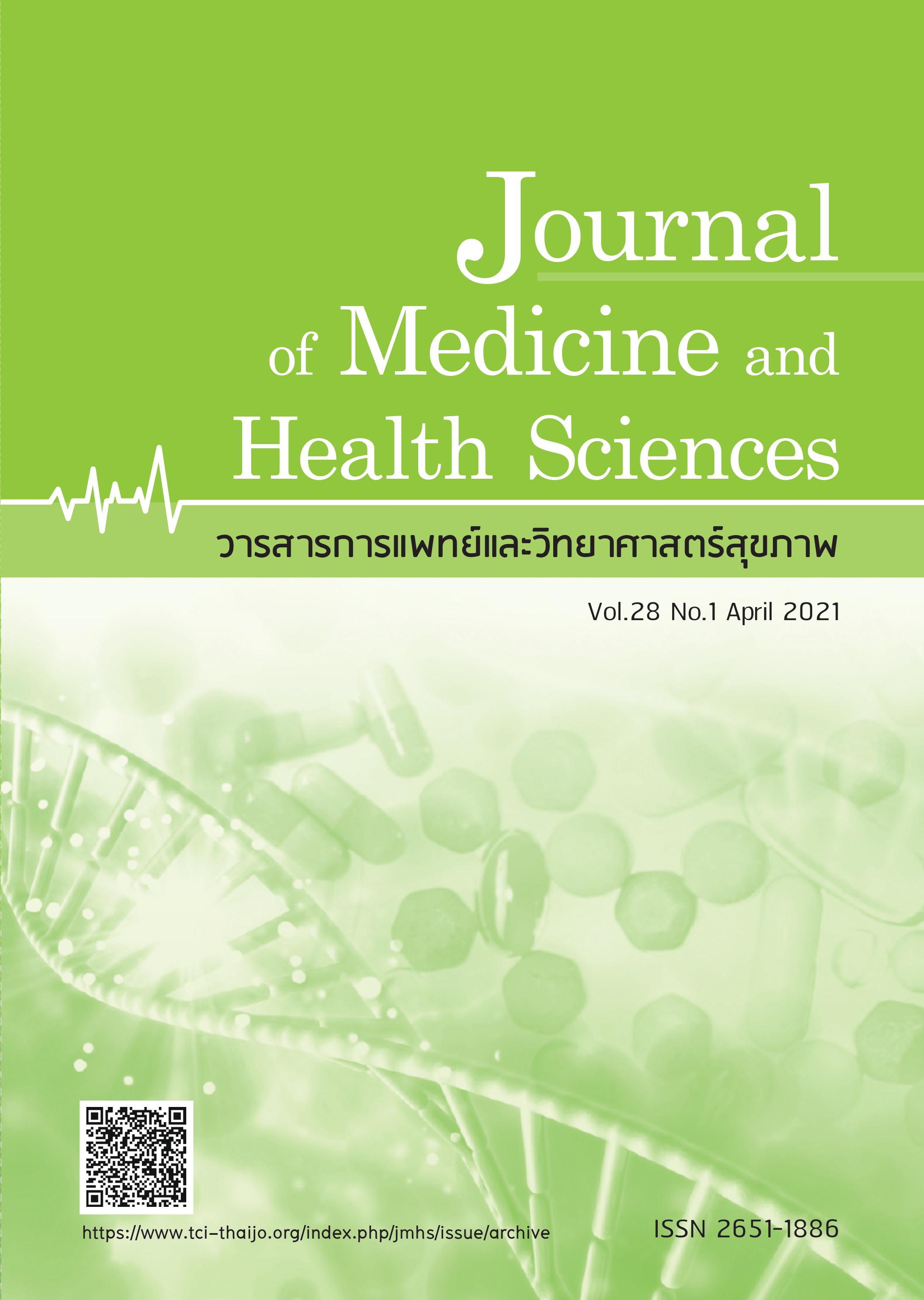Virulence genes of Vibrio parahaemolyticus isolated from acute hepatopancreatic necrosis disease associated with shrimp and grow-out pond water
Keywords:
Vibrio parahaemolyticus, acute hepatopancreatic necrosis disease, tdh, trh, pirA, pirB, virulence geneAbstract
Vibrio parahaemolyticus, a marine bacterium, is an etiologic agent of acute gastroenteritis disease outbreaks among people worldwide. A newly emerged V. parahaemolyticus caused acute hepatopancreatic necrosis disease (AHPND) among cultivated shrimp occurred in 2010. The AHPND outbreak caused major shrimp industry losses in many countries. The V. parahaemolyticus strain carried toxin genes (i.e., pirA and pirB) on its plasmid is pathogenic to shrimp. This study investigated the presence of human pathogenic genes, tdh and trh, and shrimp pathogenic genes, pirA and pirB, from AHPND related samples. A preserved stock culture of 83 V. parahaemolyticus were isolated from the AHPND affected white shrimp (n=28) and grow-out pond water (n=55) were examined. The tested strains were originally isolated from white shrimp and rearing pond water samples of one single private farm located in Eastern Thailand during the AHPND outbreak in 2013. The individual isolates were tested using the genotyping method by multiplex PCR. The results revealed that all 83 (100%) V. parahaemolyticus isolates were lacking human pathogenic virulence genes (tdh-trh-). When examined using the virulence markers of the AHPND causing strain, 74 (74/83, 89.16%) isolates were pirA-pirB- strains and nine (9/83, 10.84%) isolates (two [2/28, 7.14%] white shrimp and seven [7/55, 12.73%] grow-out pond water isolates) were pirA+pirB+ strains. This finding showed that V. parahaemolyticus with AHPND-associated genes presented in both shrimp and grow-out pond water. Consequently, probing the virulence genes of newly emerged V. parahaemolyticus strains would be essential for epidemiological surveillance and environmental monitoring.
References
2. Suthienkul O, Ishibashi M, Iida T, et al. Urease production correlates with the possession of the trh gene in Vibrio parahaemolyticus strains isolated in
Thailand. J Infect Dis 1995;172:1405-8.
3. Robert-Pillot A, Guenole A, Lesne J, et al.Occurrence of the tdh and trh genes in Vibrio parahaemolyticus isolates from waters and raw shellfish collected in two French coastal areas and raw seafood imported into France. Int J Food Microbiol 2004;91:319-25.
4. Kriem MR, Banni B, El Bouchtaoui H, et al. Prevalence of Vibrio spp. in raw shrimps (Parapenaeus longirostris) and performance of a chromogenic medium for the isolation of Vibrio strains. Lett Appl Microbiol 2015;61:224-30.
5. Su YC, Liu C. Vibrio parahaemolyticus: A concern of seafood safety. Food Microbiol 2007;24:549-58.
6. FAO. Report. The FAO/MARD Technical Workshop on Early Mortality Syndrome (EMS) or Acute Hepatopancreatic Necrosis Syndrome (AHPND) of Cultured Shrimp (under TCP/VIE/3304). Hanio, Viet Nam, 25-27 June 2013. FAO Fisheries and Aquaculture Report No. 1053. Rome.2013:1-54.
7. Han JE, Tang KFJ, Tran LH, et al.Photorhabdus insect-related (Pir) toxin-like genes in a plasmid of Vibrio parahaemolyticus, the causative agent of acute hepatopancreatic necrosis disease (AHPND) of shrimp. Dis Aquat Org 2015;113:33-40.
8. Lee CT, Chen IT, Yang YT, et al. The opportunistic marine pathogen Vibrio parahaemolyticus becomes virulent by acquiring a plasmid that expresses a deadly toxin. Proc Natl Acad Sci USA 2015;112:10798-803.
9. Theethakaew C, Nakamura S, Motooka D, et al. Plasmid dynamics in Vibrio parahaemolyticus strains related to shrimp Acute Hepatopancreatic Necrosis Syndrome (AHPNS). Infect Genet Evol 2017;51:211-8. 10. Joshi J, Srisala J, Truong VH, et al. Variation in Vibrio parahaemolyticus isolates from a single Thai shrimp farm experiencing an outbreak of acute hepatopancreatic necrosis disease (AHPND). Aquaculture 2014;428-9:297-302. 11. Siriphap A, Leekitcharoenphon P, Kass RS, et al. Characterization and genetic variation of Vibrio cholerae isolated from clinical and environmental sources in Thailand. PLoS One 2017;12:e0169324.
12. Theethakaew C, Feil E, Castillo-Ramírez S, et al. Genetic relationships of Vibrio parahaemolyticus isolates from clinical, human carrier, and environmental sources in Thailand, determined by multilocus sequence analysis. Appl Environ Microbiol 2013;79:2358-70.
13. Noguerola I, Blanch AR. Identification of Vibrio spp. with a set of dichotomous keys. J Appl Microbiol 2008;105:175-85.
14. Theethakaew C, Nakamura S, Motooka D, et al. Plasmid dynamics in Vibrio parahaemolyticus strains related to shrimp Acute Hepatopancreatic Necrosis Syndrome (AHPNS). Infect Genet Evol 2017;51:211-8.
15. Chonsin K, Matsuda S, Theethakaew C, et al. Genetic diversity of Vibrio parahaemolyticus strains isolated from farmed Pacific white shrimp and ambient pond water affected by acute hepatopancreatic necrosis disease outbreak in Thailand. FEMS Microbiol Lett 2016;363:fnv222.
16. Narayanan SV, Joseph TC, Peeralil S, et al. Prevalence, virulence characterization, AMR pattern and genetic relatedness of Vibrio parahaemolyticus isolates from retail seafood of Kerala, India. Front Microbiol 2020;11:592.
17. Kongrueng J, Yingkajorn M, Bunpa S, et al. Characterization ofVibrio parahaemolyticus causing acute hepatopancreatic necrosis disease in southern Thailand. J Fish Dis 2014;38:957-66.
18. To TTH, Yanagawa H, Thuan NK, et al. Prevalence of Vibrio parahaemolyticus causing acute hepatopancreatic necrosis disease of shrimp in shrimp, molluscan shellfish and water samples in the Mekong delta, Vietnam. Biology 2020;9:312.
19. Li Y, Hu X, Zhang X, et al. Photorhabdus luminescens PirAB-fusion protein exhibits both cytotoxicity and insecticidal activity. FEMS Microbiol Lett 2014;356:23-31.
20. Meibom KL, Blokesch M, Dolganov NA, et al. Chitin induces natural competence in Vibrio cholerae. Science 2005;310: 1824-7.
21. Parnell JJ, Rompato G, Latta LC, IV.Functional biogeography as evidence of gene transfer in hypersaline microbial communities. PLoS ONE 2010;5:e12919.
22. Taniguchi H, Ohta H, Ogawa M, et al. Cloning and expression in Escherichia coli of Vibrio parahaemolyticus thermostable direct hemolysin and thermolabile hemolysin genes. J Bacteriol 1985;162:510-5.
23. Tu WJ. Acute hepatopancreatic necrosis disease - Taiwan: (Taitung) shrimp, OIE. ProMed. 2019 Mar 13. http://www.promedmail.org, archive no. 20190309.6358727.
24. Kumagai N. Acute hepatopancreatic necrosis disease - Japan: (Okinawa) shrimp, first report, OIE. ProMed. 2020 Oct
24. http://www.promedmail.org, archive no. 20201024.7887417.
25. Nishibuchi M, Ishibashi M, Takeda Y, et al. Detection of the thermostable direct hemolysin gene and related DNA sequences in Vibrio parahaemolyticus and other Vibrio species by the DNA colony hybridization test. Infect Immun 1985;49:481-6.
26. Nishibuchi M, Taniguchi T, Misawa T, et al. Cloning and nucleotide sequence of the gene (trh) encoding the hemolysin related to the thermostable direct hemolysin of Vibrio parahaemolyticus. Infect Immun 1989;57:2691-7.



